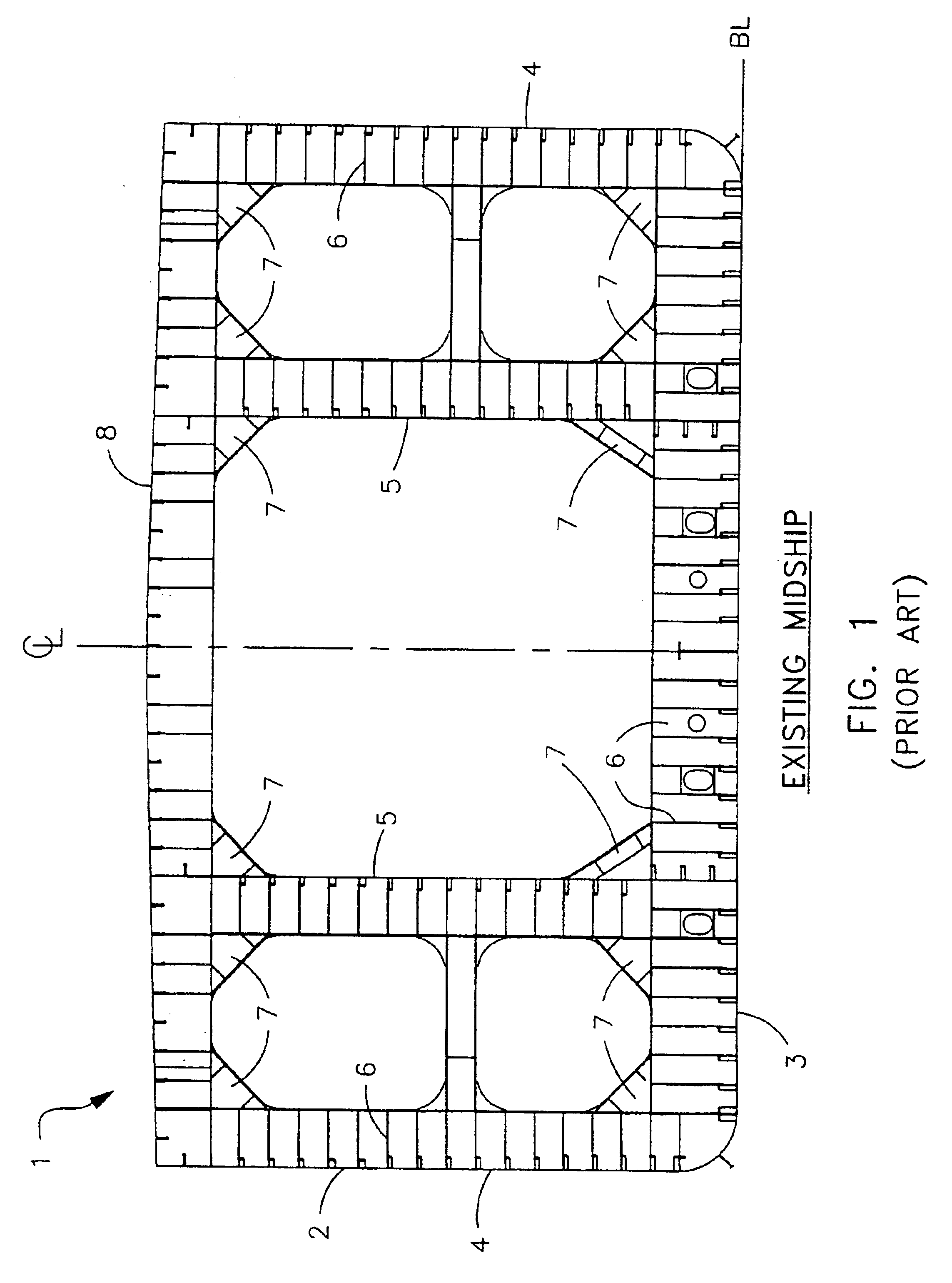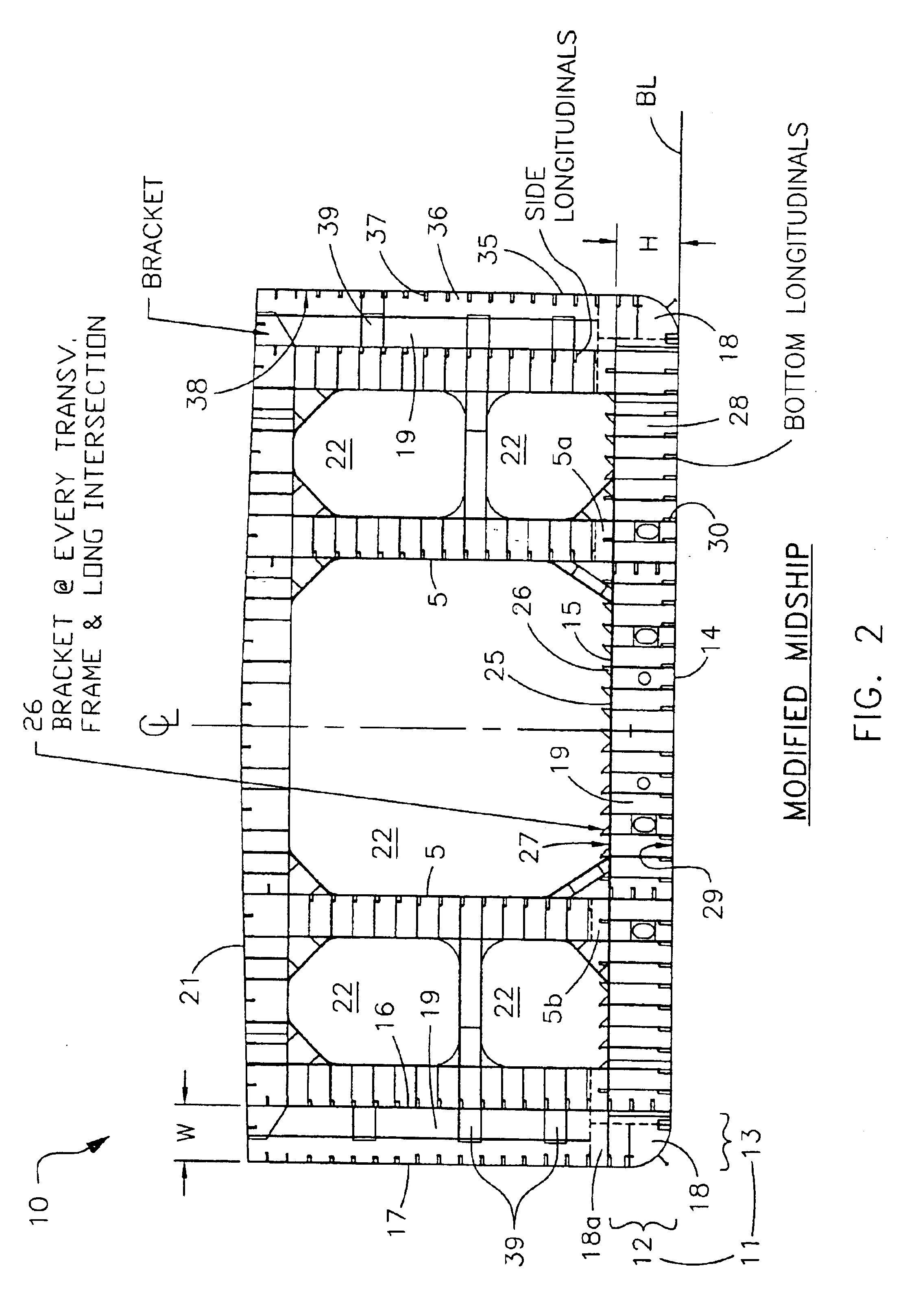In addition, new governmental and environmental regulations place certain restrictions and requirements on tank vessel owners and operators.
A problem unique to single hull tankers is that damage to the tanker's hull may lead to rupture of the tanker's cargo tanks and thus spill or leakage of the cargo.
This results not only in the loss of cargo, but also in
pollution of the marine environment and accompanying coastline.
This has created a great burden on carriers having existing single hull tankers.
These single hull tankers will either have to be rebuilt to incorporate a double hull design at great cost to the carrier, or the tankers will have to be retired, in many cases years before the end of their economically useful life.
Of course the provision of a double hull adds to the complexity and cost of new construction.
However, this external fitting of a new auxiliary hull outside the entirety of the existing single hull to form a double hull is costly and significantly changes the operational characteristics of the vessel.
Installing a new auxiliary hull over the existing bottom hull also affects the draft and lowers the baseline of the tanker, significantly affecting flow into the
propeller.
Also, this design does not meet OPA-90 requirements for minimum hull spacing.
A tank vessel having a mid-
deck configurations are comprised of vertical cargo tanks (one above the other) and double sides, but do not include double bottoms and therefore are not as effective as double hulls, and do not meet OPA-90 requirements (e.g., this type of construction in the U.S. does not constitute a double hull and is considered to be a single hull).
However, this method decreases the cargo carrying capability while at the same time also increases the draft of the vessel due to the increased weight of the double hull, both of which are undesirable.
While this internal double hull process works well for barges, it is not as effective for tankers for several reasons including (1) the use of a raised
trunk to help maintain the same cargo
carrying capacity on a rebuilt
barge causes more
visibility and operational issues on tanker than on a
barge; (2) tankers are generally three tanks across instead of two, which causes structural complications with the new double sides not normally experienced with barges; (3) tankers typically have more services (fuel, oil,
electricity, water, cargo handling, ship handling, etc.) that would be disrupted during a rebuild by
cutting up the
deck to create a raised
deck than would a typical
barge; (4) the increase in draft due to the additional weight of the new double hull would be greater for a typical tanker than a typical barge due to hull shape of a tanker, which would adversely affects marketing and may limit the cargo in several ports; (5) the extra steel weight on a tanker would represent lost cargo weight unlike the barge where the extra draft is allowed by regulation and compensates for the extra steel weight; (6) hull
bending moment issues arising from the concentrated weights in the tanker's
engine room which typically do not exist on a barge; and (7) the method used on a typical barge retrofit is difficult to accomplish on a typical tanker due to access and interference problems and modification of existing ship structure and
piping.
Another problem associated with performing double hull rebuilds of existing single hull tankers is the time that the tanker must be in a graving dock or
dry dock.
The longer the tanker must be out of the water to complete the double hull rebuild the greater the expense of the rebuild.
In addition, another problem or potential limitation associated with performing double hull rebuilds of existing single hull tankers is graving dock or
dry dock availability.
For example, the size of the tanker to be rebuilt may limit the shipyards that can satisfactorily perform the double hull rebuild and / or the method that can be used to perform the rebuild.
Still another problem associated with the double hull rebuild is caused by externally fitting a new side hull externally over the existing side hull.
The new outer side hull installed externally over the existing side hull increases the beam of the tanker and can result in a speed loss for the tanker due to an increased resistance of the tanker as it passes through the water.
The new outer side hull can also adversely effect the flow of water into the
propeller.
Furthermore, the need exists for a method of performing the double hull rebuild that reduces the time that the tanker is in a graving or
dry dock and also takes into account limitations in the size and availability of graving and dry docks.
 Login to View More
Login to View More  Login to View More
Login to View More 


